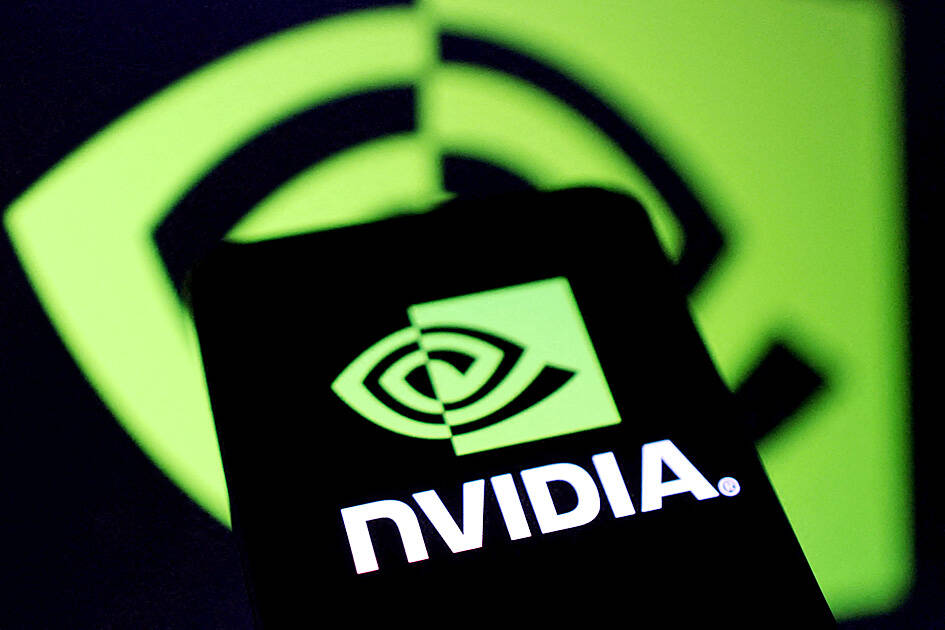An earnings report from semiconductor giant and artificial intelligence (AI) bellwether Nvidia Corp takes center stage for Wall Street this week, as stocks hit a speed bump of worries over US federal deficits driving up Treasury yields.
US equities pulled back last week after a torrid rally, as investors turned their attention to tax and spending legislation poised to swell the US government’s US$36 trillion in debt. Long-dated US Treasury yields rose amid the fiscal worries, with the 30-year yield topping 5 percent and hitting its highest level since late 2023.
Stocks were dealt another blow on Friday when US President Donald Trump targeted the European Union and Apple Inc in threats to ratchet up his trade war.

Photo: Dado Ruvic, Reuters
Focus will shift to Wednesday’s quarterly results from Nvidia, one of the world’s largest companies by market value whose stock is a major influence on benchmark equity indexes.
“All eyes are going to be on Nvidia’s report,” Horizon Investment Services LLC CEO Chuck Carlson said. “The whole AI theme has been a major driver of the market and Nvidia is at the epicenter of that theme.”
Nvidia shares are down 2 percent this year after soaring over 1,000 percent from late 2022 through the end of last year as its AI chip business spurred massive increases in revenue and profits.
Nvidia's first-quarter earnings likely jumped about 45 percent on revenue of US$43.2 billion, analysts estimated in an LSEG poll.
After big tech companies earlier in the quarter signaled robust AI-related spending, Nvidia can deliver a strong message about AI and how companies’ spending plans are faring, B Riley Wealth Advisors Inc chief market strategist Art Hogan said. “Nvidia can reinvigorate the enthusiasm for that theme.”
Nvidia, popular among smaller retail shareholders, is an investor sentiment indicator, Sarmaya Partners LLC chief investment officer Wasif Latif said.
“Given its sheer size and attention that it is commanding, there are going to be a lot of people looking for what happens with the stock,” Latif said.
US-China relations could also be in focus with Nvidia’s report. The company said last month it would take US$5.5 billion in charges after the US government limited exports of its H20 artificial intelligence chip to China.
Trade developments have whipsawed the stock market this year, especially after Trump’s April 2 announcement of sweeping tariffs on imports globally set off extreme asset price volatility.
Since then, Trump’s easing of tariffs, especially a US-China truce, has helped equities rebound. The benchmark S&P 500 index ended on Friday down 1.3 percent this year, and down 5.6 percent from its February record high.
Stocks slipped on Friday after Trump pushed for a 50 percent tariff on European Union goods starting on June 1 and threatened to impose a 25 percent tariff on Apple for any iPhones sold, but not made, in the US.
Trump’s fiscal plans consumed investor attention for much of the week, especially after Moody’s downgraded the US sovereign credit rating due to concerns about the nation’s growing debt pile.
The US House of Representatives, controlled by Trump’s Republican party, on Thursday narrowly passed a tax and spending bill that would enact much of his agenda while adding an estimated US$3.8 trillion to the debt over the next decade. The bill is heading to the US Senate for its review.
Long-dated government bond yields have been rising globally amid a selloff, although they pulled back toward the end of the week. In the US, benchmark 10-year Treasury yields last week hit their highest since February. Bond prices move opposite to yields.
Higher yields can diminish the appeal of stocks as they represent higher borrowing costs for companies and consumers, while making fixed income assets relatively more attractive.
“The biggest concern from an investment standpoint is that higher rates represent more competition for equities,” Carlson said. “If rates continue to move higher, that is going to put increasing amounts of pressure on where investors are putting their money.”

GROWING OWINGS: While Luxembourg and China swapped the top three spots, the US continued to be the largest exposure for Taiwan for the 41st consecutive quarter The US remained the largest debtor nation to Taiwan’s banking sector for the 41st consecutive quarter at the end of September, after local banks’ exposure to the US market rose more than 2 percent from three months earlier, the central bank said. Exposure to the US increased to US$198.896 billion, up US$4.026 billion, or 2.07 percent, from US$194.87 billion in the previous quarter, data released by the central bank showed on Friday. Of the increase, about US$1.4 billion came from banks’ investments in securitized products and interbank loans in the US, while another US$2.6 billion stemmed from trust assets, including mutual funds,

Micron Memory Taiwan Co (台灣美光), a subsidiary of US memorychip maker Micron Technology Inc, has been granted a NT$4.7 billion (US$149.5 million) subsidy under the Ministry of Economic Affairs A+ Corporate Innovation and R&D Enhancement program, the ministry said yesterday. The US memorychip maker’s program aims to back the development of high-performance and high-bandwidth memory chips with a total budget of NT$11.75 billion, the ministry said. Aside from the government funding, Micron is to inject the remaining investment of NT$7.06 billion as the company applied to participate the government’s Global Innovation Partnership Program to deepen technology cooperation, a ministry official told the

Taiwan Semiconductor Manufacturing Co (TSMC, 台積電), the world’s leading advanced chipmaker, officially began volume production of its 2-nanometer chips in the fourth quarter of this year, according to a recent update on the company’s Web site. The low-key announcement confirms that TSMC, the go-to chipmaker for artificial intelligence (AI) hardware providers Nvidia Corp and iPhone maker Apple Inc, met its original roadmap for the next-generation technology. Production is currently centered at Fab 22 in Kaohsiung, utilizing the company’s first-generation nanosheet transistor technology. The new architecture achieves “full-node strides in performance and power consumption,” TSMC said. The company described the 2nm process as

JOINT EFFORTS: MediaTek would partner with Denso to develop custom chips to support the car-part specialist company’s driver-assist systems in an expanding market MediaTek Inc (聯發科), the world’s largest mobile phone chip designer, yesterday said it is working closely with Japan’s Denso Corp to build a custom automotive system-on-chip (SoC) solution tailored for advanced driver-assistance systems and cockpit systems, adding another customer to its new application-specific IC (ASIC) business. This effort merges Denso’s automotive-grade safety expertise and deep vehicle integration with MediaTek’s technologies cultivated through the development of Media- Tek’s Dimensity AX, leveraging efficient, high-performance SoCs and artificial intelligence (AI) capabilities to offer a scalable, production-ready platform for next-generation driver assistance, the company said in a statement yesterday. “Through this collaboration, we are bringing two